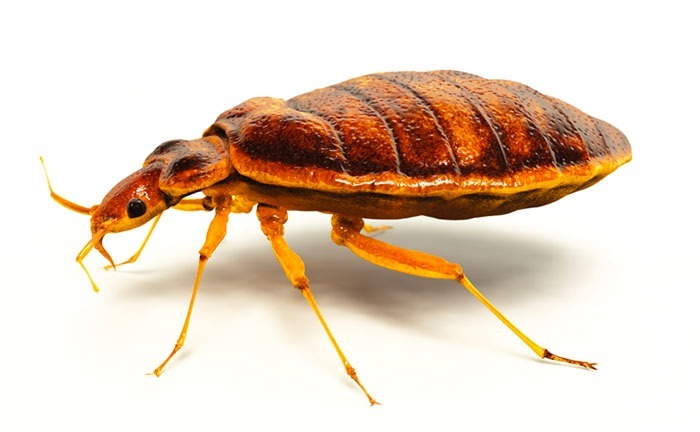Common bedbug
Cimex Lectularius

Key Features:
Adult bed bugs are 4-5 mm in length, wingless and uniformly mahogany brown in colour.
They have long well-developed walking legs with efficient tarsal claws for clinging on to the host during feeding.
Prominent antennae project from the head adjacent to the compound eyes.
Biology:
Female bed bugs lay eggs throughout their life, an unusual feature in insects. They generally produce around 2 to 3 per day and since they can live for many weeks, indeed months, each female could produce around 400-500 eggs during her lifetime. The eggs are deposited all around the environment in which the bedbug is living and are small and white or whitish/yellow about 1 mm long.
The nymph which emerges from the eggs after about 10 days at 22°C is a small version of the adult, feeding also on the blood of vertebrates.
The length of time spent in the five nymphal stages is greatly dependent upon the food resources available, temperature and relative humidity.
Bedbugs have well defined resting sites in which many individuals from all the different life stages are found. This harbourage is an essential part of the life cycle of the insect since it is in this area that the young bedbugs pick up the internal gut microorganisms which are essential to their survival.
Distribution:
This genus has representatives worldwide.
Significance:
The close association of bedbugs with human beings means that they can cause substantial nuisance through their blood-feeding habit. They feed at night on the human hosts as they are sleeping.
If the infestation is high there can be a risk of anaemia being suffered by the human hosts, although this is rare.
The nuisance and itching caused by the bites and the possibility of secondary infection is more common. Bats, chickens and other domesticated animals may also be attacked.
Control:
A thorough inspection should be made to determine the extent and source of the infestation. Bed Bugs may, for instance, have been introduced in second-hand furniture, where bugs may remain undetected for considerable periods until a suitable host appears.
All harbourages should be treated with a residual insecticide.
A very thorough treatment is needed as harbourages are diverse and difficult to detect.
The Killgerm Bed Bug Manual and Bedbug Control Practical Tips documents should be consulted prior to undertaking bed bug control.
